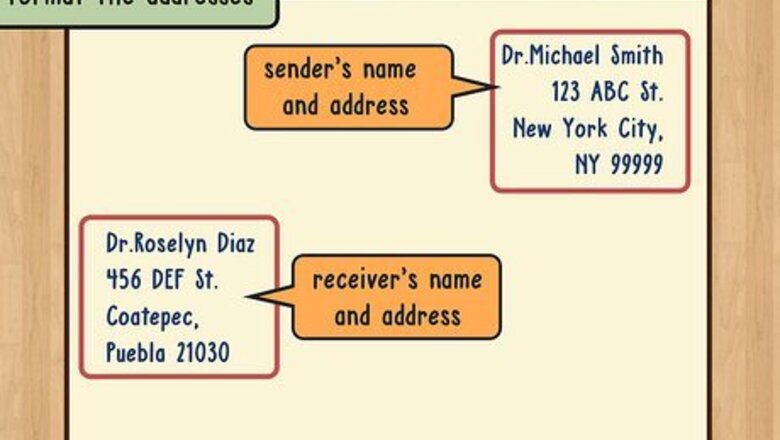
views
X
Research source
Opening Your Letter

Format the addresses. If you're writing a formal letter, put your name and address in the top right-hand corner of the page, followed by the name and address of the person to whom you're writing on the left-hand side of the page. Most word-processing applications have a business-letter template that will automatically format your letter this way. If you plan to print your letter on letterhead, you don't need to include your name and address. When writing an email, you normally don't include the addresses at the top of the page.
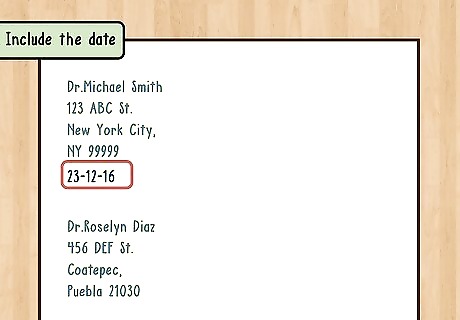
Include the date. If you're sending a formal letter, it is customary to write the date the letter was written at the top. In Spanish letters, the date may be preceded by the city where you are located when you write the letter. For example, you might write "Acapulco, 23 de diciembre de 2016." Spanish dates follow the convention of writing the day first, followed by the month, with the year last. If you're using just numbers, you would write the same date "23-12-16." For letters printed on letterhead, or more casual letters to friends or acquaintances, place the date in the top right-hand corner where you normally would put your name and address. Formal business letters typically have the date on the left-hand side of the paper below the names and addresses.
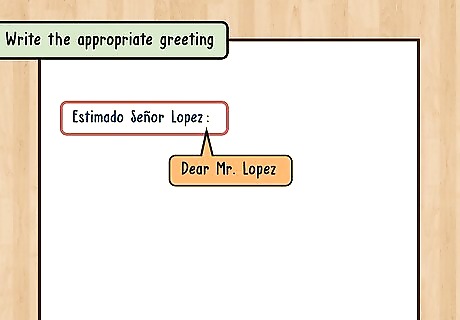
Write the appropriate greeting. How you greet the person to whom you're writing in Spanish depends on the person's relationship to you and how well you know them. Casual greetings that might be appropriate for a friend or acquaintance might be offensive to someone who is older than you, or who you don't know personally. You can address your letter A quien corresponda: (or "to whom it may concern") if you don't know the name of the specific person who will read the letter. This greeting is appropriate for general business letters, such as when you're seeking more information about a product or service. If the person is older than you, or if you're writing them for the first time, use Estimada/o plus the person's surname. Address them as señor or señora where appropriate. For example, you might write "Estimado Señor Lopez." This greeting literally translates to "Esteemed Mr. Lopez," but is similar to writing "Dear Mr. Lopez" in English. When you have a close relationship with the person, you can use Querido/a followed by their first name. For example, you might write "Querida Benita," or "Dear Benita." In a Spanish letter you should follow your greeting with a colon, rather than with the comma that is commonly used in English.
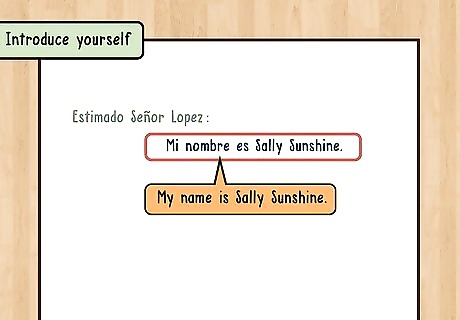
Introduce yourself. In the first line of your letter, you want to let the person know who you are. Begin your letter by saying Mi nombre es and writing your full name. If it's important to your letter, you also should add your job title or relationship to the receiver of the letter. For example, you might write "Mi nombre es Sally Sunshine." Follow that with a sentence that explains who you are, such as if you are a student at a university or you are related to a friend of theirs. If you're writing on someone else's behalf, you would add Escribo de parte de followed by the name of that person. For example, you might write "Escribo de parte de Margarita Flores."
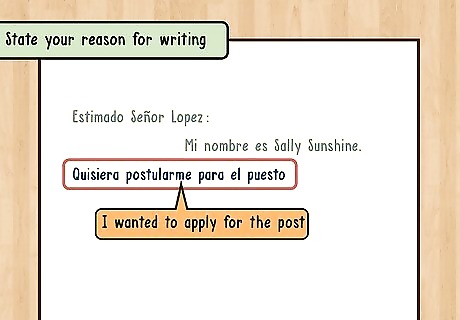
State your reason for writing. Immediately after you've introduced yourself, you need to explain briefly why you're writing to that person or what you want from them. You'll go into more detail in the body of your letter, but you want to set up the purpose of the letter immediately. You can think of this as a summary of your letter. For example, if you're writing a letter to inquire about a job or internship being offered, you might write Quisiera postularme para el puesto, meaning "I wanted to apply for the post." You would then go on to describe where you saw the post advertised or how you came to know about it. This section should be no more than a sentence or two, and will conclude the first introductory paragraph of your letter.
Crafting the Body of Your Letter
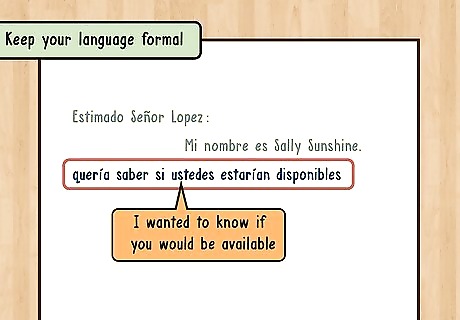
Keep your language formal. Even if you're on relatively good terms with the person to whom you're writing, Spanish letter writing uses more formal and polite language than you might use if you were writing the letter in English. In Spanish, formal writing tends to be more passive than language you might be more accustomed to using in English. Speak conditionally (quería saber si ustedes estarían disponibles or "I wanted to know if you would be available") and use the formal "you" (usted or ustedes) unless you are on close personal terms with the person. If you're unsure how formal your letter should be, err on the side of formality. You are less likely to offend someone by being overly polite and formal than by being too casual or overly familiar. If you've met the person several times before, or if you're responding to a letter they've written you, use those previous exchanges to guide your formality. You should never be less formal than the other person was to you. Even if you're writing an email, colloquialisms or slang and abbreviations used in texting or casual conversation on the internet are not appropriate to use when you are writing a letter in Spanish.

Start with your most important point. For the body of your letter, state your points or information in decreasing order of importance. Aim to write in a clear, concise way so that your letter ends up being no more than a page long. A personal letter, such as a letter to a friend describing your experiences on vacation, can be as long as you like. But for a business or other formal letter, be respectful of the receiver's time. Avoid going off on tangents that are unrelated to the purpose of the letter. You will impress the person more with your ability to write a formal letter correctly. It may help to outline your letter briefly before you start writing, so that you know exactly what points or statements you want to make, and how you want to make them. Having your organization down ahead of time makes writing easier, especially if you're not writing in your first language.
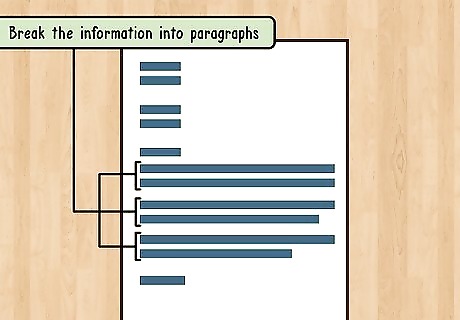
Break the information into paragraphs. Your letter should be single-spaced, with a double-space between each paragraph. A paragraph doesn't need to be more than two or three sentences long. For each separate idea or point in your letter, you should have a separate paragraph. For example, suppose you're writing a Spanish letter to apply for an internship. You have two basic points that you want to get across: your experience, and why you would be the best applicant for the internship. Your letter will include an introductory paragraph, a paragraph about your experience, a paragraph about why you're the best applicant, and a closing paragraph.
Closing Your Letter
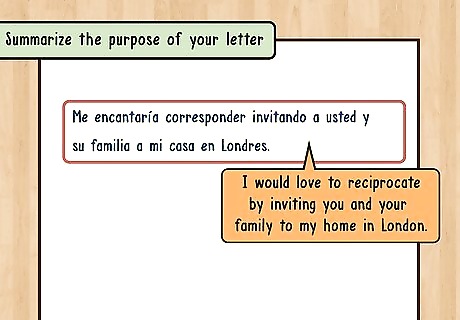
Summarize the purpose of your letter. Begin your closing paragraph with a sentence or two that summarizes your reason for writing. You also want to include any closing remarks that are relevant to the subject of your letter. For example, if you are writing to apply for a job or internship, you might include a statement in your closing that you have references that are available upon request. If your letter is only a couple of paragraphs, this may not be necessary. However, it can be helpful for longer letters that are a couple of pages long, as it will bring your reader back to the reason you wrote to them in the first place. This portion of the closing paragraph also typically isn't important if you are writing to a close friend or family member.
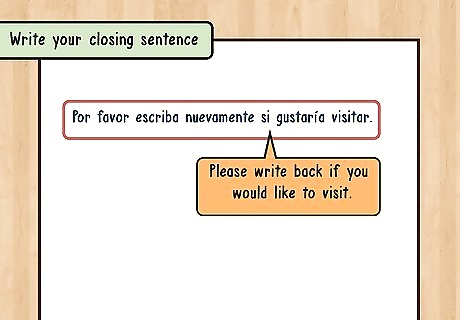
Write your closing sentence. To end your letter, let the person to whom you're writing know what you expect as a result of the letter. In this final sentence, you will let them know what decision you hope for them to make or when you expect to hear from them. For example, if you simply want a reply, but don't have any definite timetable, you might write Espero su respuesta, which means "I await your reply." If you anticipate that the recipient may have questions or want to talk to you further, you might write Cualquier cosa estoy a su disposición, which means "I am available should you have any questions."
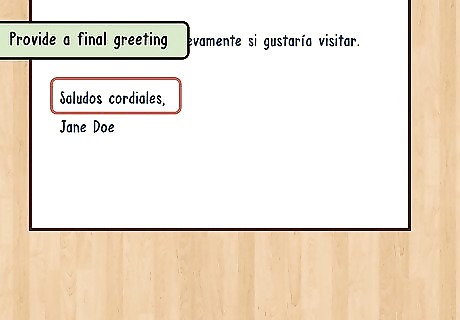
Provide a final greeting. Much as you would end a letter in English by writing a word or phrase such as "Sincerely yours" or "All the best," a similar word or phrase in Spanish will close out your Spanish letter. Closing greetings in Spanish tend to be a bit more formal than they are in English. Commonly, you would use something such as Saludos cordiales, meaning "Cordial greetings." If you're asking the person for something, you might use Gracias y saludos, meaning "Thank you and greetings." If you don't know the person at all, and they are older than you or in a position of authority, you might use Le saludo atentamente. This phrase is the most formal closing greeting, and can be literally translated as "I attentively send greetings." It is so formal that you're almost implying that you may not even be worthy of greeting the person. When writing to a close friend or family member, use a closing greeting such as Besos, which means "kisses." It may seem more intimate than a closing greeting you would use in English, but it's a common way to close Spanish letters.
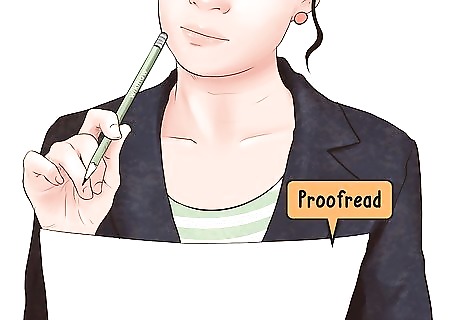
Proofread your letter carefully. Particularly if you wrote your letter using a word-processing application that defaults to English, you may have significant errors in punctuation or spelling. A sloppy letter reflects poorly on you and may signal that you don't respect the person to whom you're writing. If you have auto-correct enabled on your word-processing application, check your words carefully – especially if the application's default language is English. It may change some words to their closest English equivalent without you noticing. Pay particular attention to punctuation. For example, Spanish questions begin with a "¿" and end with "?". This construction is unique to Spanish, and if you're not used to writing in Spanish you may omit the opening mark.
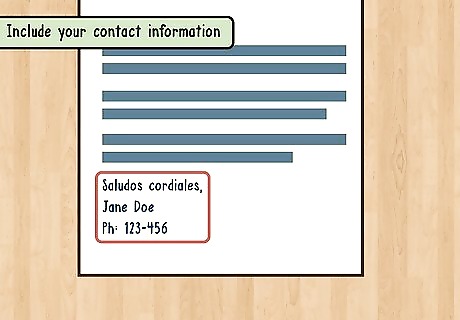
Include your contact information. Even if you have contact information at the top of the letter, it is customary to include direct contact information under your typed name. This is particularly important if you are writing in your capacity as an employee. For example, if you're typing your letter on your employer's letterhead, the letterhead typically includes general contact information for the company – not contact information for you personally. Include the information that corresponds to your preferred method of communication. If you want the recipient of the letter to call you, put your phone number after your name. On the other hand, if you'd prefer they send you an email, give them your email address.
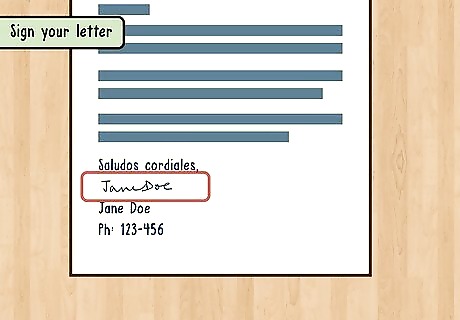
Sign your letter. When you're certain that your letter is error-free, print and sign it just as you would an English letter. Typically you'll leave a few blank lines under the closing greeting and then type your name. When you sign your letter, sign it above your typed name. If the letter is for an official purpose, you may want to make a copy of your signed letter for your own records before you mail it off.




















Comments
0 comment